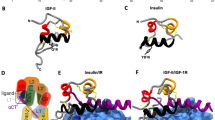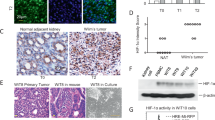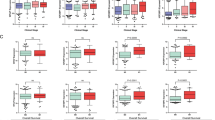Abstract
Wilms tumor is a common embryonic tumor in childhood. Two Wilms tumor-suppressor genes, WT1 and WT2, are located on chromosome 11p, WT2 at 11p15.5 close to the IGF-II gene, which is highly expressed in some Wilms tumors. We established Wilms tumor cell lines to investigate the regulation of tumor cell growth by IGF-II. We demonstrated that Wilms tumor cells produce more IGF-II than normal kidney cells. Both types I and II IGF receptors reside on these cells. In serum-free culture medium, tumor cell growth is reversibly inhibited by suramin via interfering with IGF-II binding. Wilms tumor cell growth is also arrested by IGF binding protein-3, capturing the continuously produced IGF-II, and by αIR-3, a type I IGF receptor-blocking antibody. Thus, we demonstrated the whole loop of elevated synthesis, secretion, receptor binding, and autocrine growth stimulation of IGF-II through type I IGF receptor in Wilms tumor cell cultures. We concluded that IGF-II plays a crucial role in the regulation of growth of this embryonic tumor. Overproduction of IGF-II by the tumor cell is the limiting step for Wilms tumor growth, supporting its important role as an embryonic growth factor.
Similar content being viewed by others
Log in or create a free account to read this content
Gain free access to this article, as well as selected content from this journal and more on nature.com
or
Abbreviations
- rhIGF-I and rhIGF-II:
-
recombinant human IGF-I and -II
- IGFBP-3:
-
IGF binding protein-3
- αIR-3:
-
type I IGF receptor antibody
- DMEM:
-
Dulbecco's modified Eagle's medium
References
Brissenden JE, Ulrich A, Francke U 1984 Human chromosomal mapping of genes for insulin-like growth factor I and II and epidermal growth factor. Nature 310: 781–784
Tricoli J, Rall LB, Scott J, Bell GI, Shows TB 1984 Localization of insulin-like growth factor genes to human chromosomes 11 and 12. Nature 310: 784–786
Rinderknecht E, Humbel RE 1978 The amino acid sequence of human insulin-like growth factor I and its structural homology with proinsulin. J Biol Chem 253: 2769–2776
Rinderknecht E, Humbel RE 1978 Primary structure of insulin-like growth factor II. FEBS Lett 149: 105–108
Moses AC, Nissley SP, Short PA, Rechler MM, White RM, Knight AB, Higa OZ 1980 Increased levels of multiplication-stimulating activity, an insulin-like growth factor, in fetal rat serum. Proc Natl Acad Sci USA 77: 3649–3653
Underwood LE, D'Ercole AJ 1984 Insulin-like growth factor/somatomedins in fetal and neonatal development. Clin Endocrinol Metab 13: 69–89
DeChiara TM, Efstratiadis A, Robertson EJ 1990 A growth deficiency phenotype in heterozygous mice carrying an insulin-like growth factor II gene disrupted by targeting. Nature 345: 78–80
Delhanty PJ, Han VK 1993 The expression of insulin-like growth factor binding protein-2 and IGF-II genes in the tissues of the developing ovine fetus. Endocrinology 132: 41–52
Schoenle EJ, Zapf J, Humbel RE, Froesch ER 1982 Insulin-like growth factor I stimulates growth in hypophysectomized rats. Nature 296: 252–253
Schoenle EJ, Hauri C, Steiner T, Zapf J, Froesch ER 1985 Comparison of in vivo effects of insulin-like growth factors I and II and of growth hormone in hypophysectomized rats. Acta Endocrinol 108: 167–174
Walker JL, Van Wyk JJ, Underwood LE 1992 Stimulation of statural growth by recombinant insulin-like growth factor I in a child with growth hormone insensitivity syndrome (Laron type). J Pediatr 121: 641–646
Laron Z, Anin S, Kipper-Aurbach Y, Klinger B 1992 Effects of insulin-like growth factor on linear growth, head circumference and body fat in patients with Laron-type dwarfism. Lancet 339: 1258–1261
Cariani E, Lasserre C, Seurin D, Hamelin B, Kemene F, Franco D, Czech MP, Ulrich A, Brechot C 1988 Differential expression of insulin-like growth factor II mRNA in human primary liver cancers, benign liver tumors, and liver cirrhosis. Cancer Res 48: 6844–6849
Scott J, Cowell J, Robertson ME, Priestley LM, Wadey R, Hopkins B, Pritchard J, Bell GI, Rall B, Graham CF, Knott TJ 1985 Insulin-like growth factor-II gene expression in Wilms tumour and embryonic tissues. Nature 317: 260–262
Reeve A, Eccles MR, Wilkins RJ, Bell GI, Millow LJ 1985 Expression of insulin-like growth factor II transcripts in Wilms tumour. Nature 317: 258–260
Irminger JC, Schoenle EJ, Briner J, Humbel RE 1989 Structural alteration of the insulin-like growth factor II-gene in Wilms tumour. Eur J Pediatr 148: 620–623
Ren-Qiu Q, Ruelicke T, Hassam S, Haselbacher GK, Schoenle EJ 1993 Systemic effects of insulin-like growth factor-II produced and released from Wilms tumor tissue. Eur J Pediatr 152: 102–106
Haselbacher GK, Humbel RE 1982 Evidence for two species of insulin-like growth factor II (IGF II and “big” IGF II) in human spinal fluid. Endocrinology 110: 1822–1824
Haselbacher GK, Schwab ME, Pasi A, Humbel RE 1985 Insulin-like growth factor II (IGF-II) in human brain: regional distribution of IGF-II and of higher molecular mass forms. Proc Natl Acad Sci USA 82: 2153–2157
Zapf J, Walter H, Froesch ER 1981 Radioimmunological determination of insulin-like growth factors I and II in normal subjects and in patients with growth disorders and extrapancreatic tumor hypoglycemia. J Clin Invest 68: 1321–1330
Blum WF, Ranke MB, Bierich JR 1988 A specific radioimmunoassay for insulin-like growth-factor II: the interference of IGF binding proteins can be blocked by excess IGF-I. Acta Endocrinol 118: 374–380
Ferguson-Smith AC, Cattanach BM, Barton SC, Beechey CV, Surani MA 1991 Embryological and molecular investigations of parental imprinting on mouse chromosome 7. Nature 351: 667–670
Henry I, Bonaiti-Pellié C, Chehensse V, Beldjord C, Schwartz C, Utermann G, Junien C 1991 Uniparental paternal disomy in a genetic cancer-predisposing syndrome. Nature 351: 665–667
Green DM, Breslow NE, Beckwith JB, Norkool P 1993 Screening of children with hemihypertrophy, aniridia, and Beckwith-Wiedemann syndrome in patients with Wilms tumor: a report from the national Wilms tumor study. Med Pediatr Oncol 21: 188–192
Waziri M, Patil SR, Hanson JW, Bartley JA 1983 Abnormality of chromosome 11 in patients with features of Beckwith-Wiedemann syndrome. J Pediatr 102: 873–876
Turleau C, deGrouchy J, Chavin-Colin F, Martelli H, Voyer M, Charlas R 1984 Trisomy 11p15 and Beckwith-Wiedemann syndrome. A report of two cases. Hum Genet 67: 219–221
DeChiara TM, Efstratiadis A, Robertson EJ 1990 A growth-deficiency phenotype in heterozygous mice carrying an insulin-like growth factor II gene disrupted by targeting. Nature 345: 78–80
Gessler M, Poustka A, Cavenee W, Neve RL, Orkin SH, Bruns GAP 1990 Homozygous deletion in Wilms tumours of a zinc-finger gene identified by chromosome jumping. Nature 343: 774–778
Reeve A, Housiaux PJ, Gardner GM, Chewings WM, Grindley RM, Millow LJ 1984 Loss of a Harvey ras allele in sporadic Wilms tumour. Nature 309: 174–176
Dao DD, Schroeder WT, Chao LY, Kikuchi H, Strong LS, Riccardi VM, Pathak VM, Nichols WW, Lewis WH, Saunders GF 1987 Genetic mechanisms of tumour specific loss of 11p DNA sequences in Wilms tumour. Am J Hum Genet 41: 202–217
Dowdy SF, Fasching CL, Araujo D, Lai KM, Livanos E, Weissman BE, Stanbridge EJ 1991 Suppression of tumorigenicity in Wilms tumor by the p15.5-p14 region of chromosome 11. Science 254: 293–295
Drummond IA, Madden SL, Rohwer-Nutter P, Bell GI, Sukhatme VP, Rauscher FJ 1992 Repression of the Insulin-like growth factor II gene by the Wilms tumor suppressor WT1. Science 257: 674–678
Weissman BE, Saxon PJ, Pasquale SR, Jones GR, Geiser AG, Stanbridge EJ 1987 Introduction of a normal human chromosome 11 into a Wilms tumor cell line controls its tumorigenic expression. Science 236: 175–180
Zapf J, Schoenle E, Froesch ER 1978 Insulin-like growth factors I and II: Some biological actions and receptor binding characteristics of two purified constituents of nonsuppressible insulin-like activity in human serum. Eur J Biochem 87: 285–296
Zapf J, Froesch ER, Humbel RE 1981 The insulin-like growth factors (IGF) of human serum: chemical and biological characterization and aspects of their possible physiological role. Curr Top Cell Regul 19: 257–309
Rechler MM, Nissley SP 1985 The nature and regulation of the receptors for insulin-like growth factors. Annu Rev Physiol 47: 425–442
Kull FC, Jacobs S, Su YF, Svoboda ME, van Wyk JJ, Cuatrecasas P 1983 Monoclonal antibodies to receptors for insulin and somatomedin-C. J Biol Chem 258: 6561–6565
Gansler T, Furlanetto R, Gramling TS, Robinson KA, Blocker N, Buse MG, Sens DA, Garvin AJ 1989 Antibody to type I insulin-like growth factor receptor inhibits growth of Wilms tumor in culture and in athymic mice. Am J Pathol 135: 961–966
Hawking F 1978 Suramin: with special reference to onchocerciasis. Adv Pharmacol Chemother 15: 289–322
Pollack M, Richard M 1990 Suramin blockade of insulin-like growth factor I-stimulated proliferation of human osteosarcoma cells. JNCI 82: 1349–1352
Hosang M 1985 Suramin binds to platelet-derived growth factor and inhibits its biological activity. J Cell Biochem 29: 265–273
El-Badry OM, Minniti C, Kohn EC, Houghton PJ, Daughaday WH, Helman LJ 1990 Insulin-like growth factor II acts as an autocrine growth and motility factor in human rhabdomyosarkoma tumors. Cell Growth Differ 1: 325–331
Acknowledgements
The authors are grateful to Dr. T. Torresani and L. Alig-Schuster for their important contributions and technical help to this study.
Author information
Authors and Affiliations
Additional information
Supported by the “Stiftung zur Krebsbekämpfung,” the Roche Research Foundation, the Julius Müller Foundation, the Deutsche Forschungsgemeinschaft (DFG grant Schm 943/1-1), and by the Swiss National Science Foundation (grants 32-29863.90 and 32-39427.93).
Rights and permissions
About this article
Cite this article
Ren-Qiu, Q., Schmitt, S., Ruelicke, T. et al. Autocrine Regulation of Growth by Insulin-Like Growth Factor (IGF)-II Mediated by Type I IGF-Receptor in Wilms Tumor Cells. Pediatr Res 39, 160–165 (1996). https://doi.org/10.1203/00006450-199601000-00025
Received:
Accepted:
Issue date:
DOI: https://doi.org/10.1203/00006450-199601000-00025
This article is cited by
-
A model to explain specific cellular communications and cellular harmony:- a hypothesis of coupled cells and interactive coupling molecules
Theoretical Biology and Medical Modelling (2014)
-
Progress of fundamental research in Wilms' tumor
Urological Research (1997)



